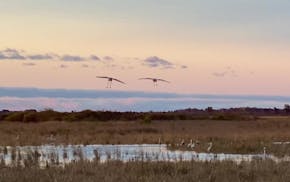
Raking won't make the snow melt. It won't thaw the ground. Or give the temperatures a boost. What will it do? "More harm than good," said Brian Horgan, a turf grass expert and associate professor at the University of Minnesota. While we may have come out of hibernation, our grass has not. "It's still fragile," said Horgan. "It can't withstand wear and tear — and that means raking." He expects the grass to be rake-ready by the first of May. "It kind of pops up," he said. "You'll be able to see it." What can you do until then? "Go to a park," he advised.
By deb brown • Special to the Star Tribune
I may be stating the obvious, but it's too early to get your yard and garden ready for the growing season. Although the timing of spring chores can't be dictated by the calendar, jumping the gun can be a waste of effort, and sometimes a waste of money. Here are some guidelines for what to do, and when:
Lawn care
Try to stay off the grass as much as possible while the soil is still moist and spongy underfoot. Because we had so much snow late this winter, we might have quite a bit of snow mold. If you see matted areas in the lawn, use a lightweight leaf rake to break them up. Usually, letting air and sunshine penetrate is all that's necessary for grass to recover from snow mold.
If you fertilized the lawn last September, you probably won't need to fertilize again this spring. However, if you do plan to fertilize the lawn, wait until it's growing actively enough that you've had to mow it a couple times. Only then will grass plants be able to make best use of the nutrients.
If you've had a lot of trouble with crabgrass or other annual weeds in your lawn, you can use a product combining fertilizer with a pre-emergence herbicide in the affected areas. If you'd like to try a greener product, use one containing corn gluten meal. It prevents many annual seeds from sprouting and provides a natural source of nitrogen. It does take several years of applications to be most effective.
Pre-emergence herbicides should be applied and watered lightly into the lawn two weeks before crabgrass is expected to sprout. Typically, that means waiting until the last week of April or the first week of May. Because their effectiveness wanes over time, there is no reason to apply crabgrass preventers early. Don't use these products if you plan to seed, unless you find one designed specifically for use with newly planted grass seed.
Gradually remove mulch
If you mulched your spring bulbs and other perennials, gradually remove the mulch as it thaws. You may choose to leave the mulch between plants, where it will keep the soil moist and help prevent annual weeds from sprouting.
Tender, hybrid tea roses are usually uncovered or lifted around mid-April most years. This year, however, you might want to wait. The canes of hyrbrid tea roses may be damaged or killed if nighttime temperatures drop into the teens.
Unwrap trees
If you used paper or plastic tree wrap to protect young trees from sunscald or animal damage, remove it immediately. The wrap holds moisture against the trunk, which can promote diseases.
If you're concerned about rabbits and other critters gnawing on the thin bark, create a more permanent barrier. Make a cylinder of hardware cloth or chicken wire and place it around the base of your tree. Be sure to leave an inch or two of space between the cylinder and the trunk. Be sure to remove the cylinder if it begins to constrict the trunk's growth.
Stay out of the garden
Wait until soil dries sufficiently before working in the garden. You can test for dryness by lifting some soil with a shovel, then making a small ball in your fist. If the soil is dry enough, the ball will be crumbly. If it stays together tightly, it is still too moist. Wait a few days and try again.
Prune with caution
Hold off pruning forsythia, lilacs and other shrubs that bloom in spring or early summer. If you prune now, you'll sacrifice this year's flowers.
A few shrubs bloom on new stems that are produced this spring, such as old-fashioned snowball hydrangeas and pink-flowering spireas, for instance. Those may be pruned in spring as they begin to grow, and they'll still flower this summer.
Wait to prune evergreen shrubbery such as junipers, yews and arborvitae, until you see new growth. Then, you can cut them back as long as you don't remove all the new growth. These plants will keep growing all summer; you can prune them again in early to mid-July if you want to limit their size. Wait, too, to shorten the new growth of spruce and pines.
Hire an arborist if your shade trees need pruning. It's not a job homeowners should tackle. To avoid oak wilt disease, oaks can't be pruned in April, May or June. And though it's not harmful, some trees — notably maples — will drip lots of sap when they're pruned in spring.
Keep strawberries covered
Strawberries can be killed when night temperatures fall to the mid-teens, so don't be too eager to uncover them. When you do, keep the mulching material close by, so you can rake it over the plants if we get a cold spell.
Deb Brown is a garden writer and former extension horticulturist with the University of Minnesota

A Minnesota field guide to snow shovels: Which one's best?
Sign up for Star Tribune newsletters


